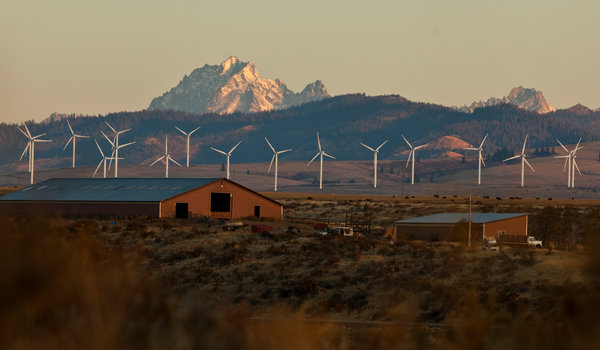forum
library
tutorial
contact

Wind Turbines Generate
Prompt Energy Payback -- Study
by Daniel Cusick
E & E, June 18, 2014
|
the film forum library tutorial contact |

|
Wind Turbines Generate
by Daniel Cusick
|
A typical Pacific Northwest wind farm will pay back the energy used in its
manufacture and installation within five to eight months of coming into service.
 The energy required to build a new commercial-scale wind turbine
amounts to only a small amount of what the turbine will produce over a
projected 20-year life span, according to a new life-cycle analysis of
wind turbines performed by Oregon State University researchers.
The energy required to build a new commercial-scale wind turbine
amounts to only a small amount of what the turbine will produce over a
projected 20-year life span, according to a new life-cycle analysis of
wind turbines performed by Oregon State University researchers.
The environmental analysis, published in the International Journal of Sustainable Manufacturing, concludes that a 2-megawatt turbine built for a typical Pacific Northwest wind farm will pay back the energy used in its manufacture and installation within five to eight months of coming into service.
"All forms of energy generation require the conversion of natural resource inputs, which are attendant with environmental impacts and costs that must be quantified to make appropriate energy system development decisions," authors Karl Haapala and Preedanood Prempreeda explain in the paper.
The research examines the life cycle of two wind turbines to be installed and operated in the Columbia River Gorge on the Oregon- Washington border.
The greatest environmental impacts associated with the wind turbines, according to the paper, stem from the production of raw materials like steel, copper, fiberglass and other composites, and the energy required to manufacture turbine components such as the nacelle, tower and rotor.
Such inputs can drive up the overall cost of wind turbines, the authors found. But "even in a worst-case scenario, lifetime energy requirements for each turbine will be subsumed by the first year of active use. Thus, for the 19 subsequent years, each turbine will, in effect, power over 500 households without consuming electricity generated using conventional energy sources."
Life-cycle analyses for wind turbines account for the cost of sourcing of key raw materials as well as the transport, manufacturing, installation of the turbine; ongoing maintenance over a projected 20 years of operation; and the impacts of recycling and disposal after the turbine is retired.
While life-cycle analyses, including those that measure CO2 emissions associated with the manufacture and installation of wind turbines, have been more common in Europe, relatively few have examined the U.S. wind energy sector.
But Michael Goggin, director of research for the American Wind Energy Association, said in a statement that the results "validate a large number of peer-reviewed studies, all of which show that wind energy quickly becomes a net energy and emissions saver, typically within a few months of operations."
learn more on topics covered in the film
see the video
read the script
learn the songs
discussion forum
